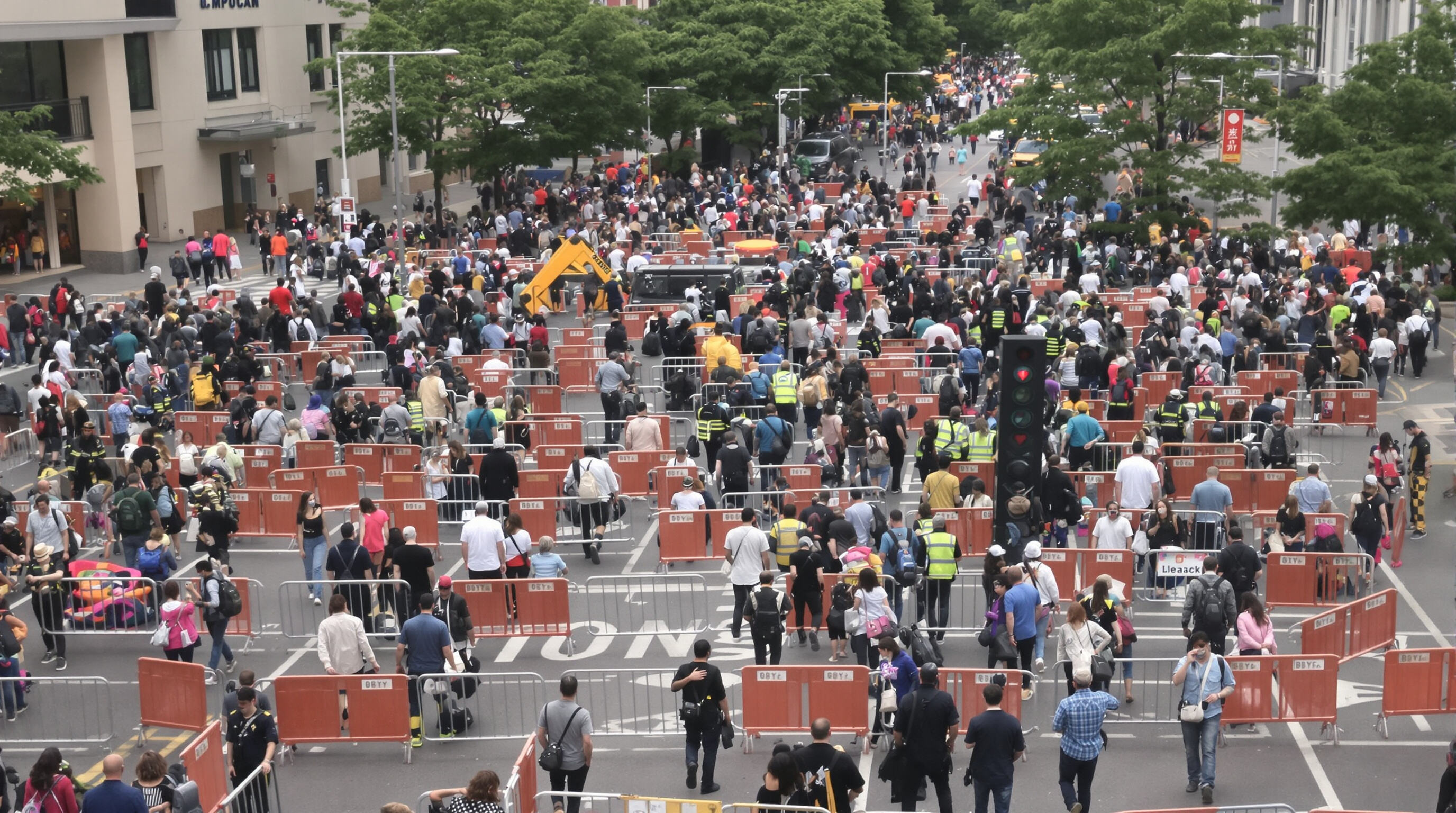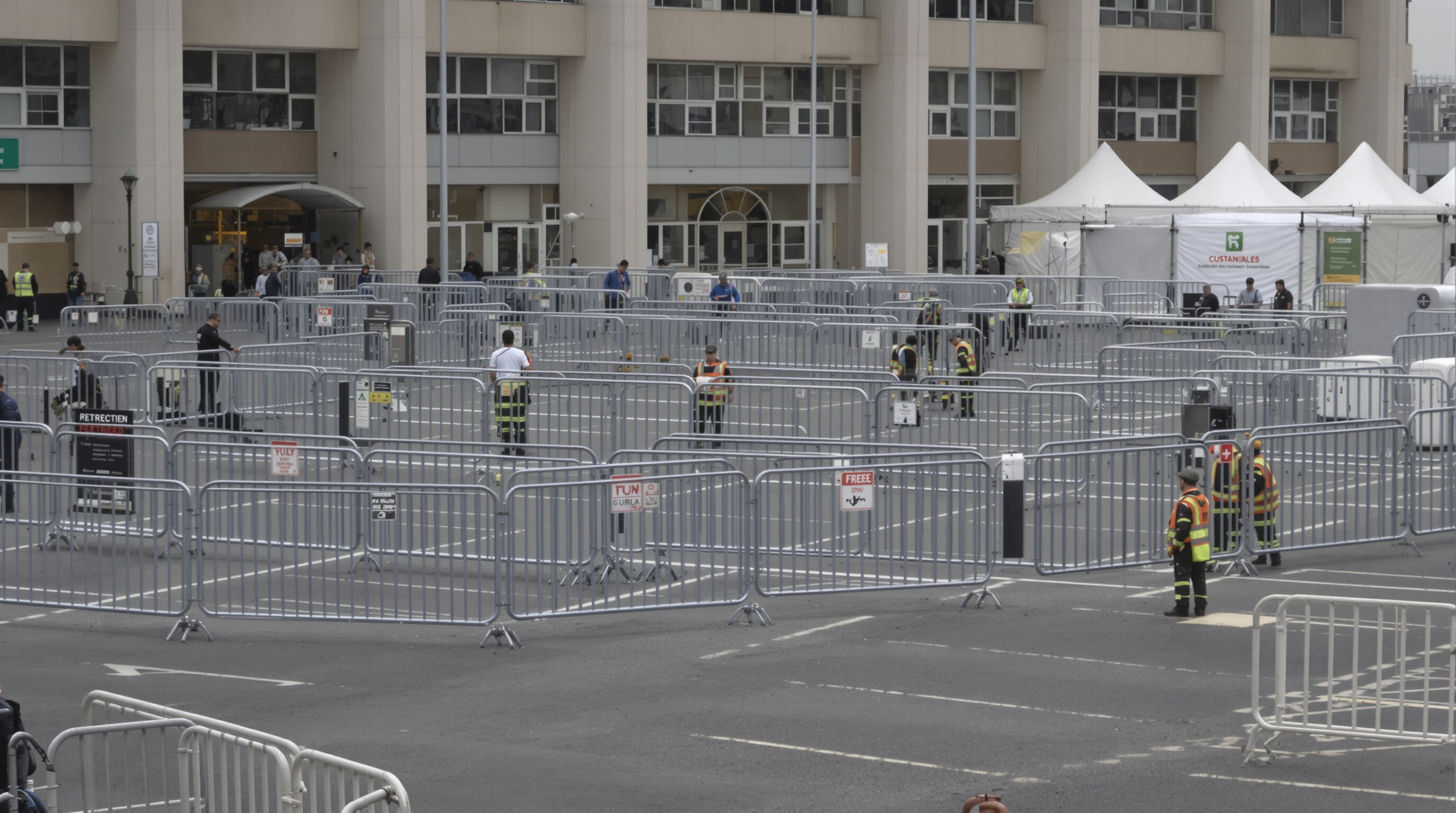The Application and Advantages of Crowd Control Barrier Fences
Enhancing Public Safety with Crowd Control Barrier Fences

The Role of Crowd Control in Urban Public Safety
Modular crowd control barriers really help manage foot traffic in busy city areas where people pack together tightly. According to research from the Urban Safety Institute back in 2023, cities using these systems reported about 42 percent fewer accidents related to crowds during big events than places without any sort of barriers. These fences do double duty by creating defined walking paths while still letting emergency personnel see what's going on around them. Public spaces become safer overall when there's some kind of structure guiding how people move through them, plus it makes things easier for those responding to emergencies too.
Mitigating Risks of Crowd Crush and Overcrowding
Barrier systems that are set up temporarily help cut down on dangerous crowd compression by doing three main things. First, they create space between packed areas where people might otherwise push together. Second, these barriers often direct crowds in one direction rather than letting them all move at once. And finally, they keep certain paths clear so emergency personnel can get through if needed. Event planners who follow the guidelines from the Event Safety Alliance (which recommends no more than about 4.7 people per square meter) tend to see around half as many medical problems caused by too many bodies in too small a space. This makes sense when we think about basic safety principles applied to large gatherings.
Case Study: Preventing Incidents at Music Festivals and Mass Gatherings
A 2022 analysis of 17 major outdoor festivals found that venues using perimeter fencing with staggered entry points reduced crowd surge incidents by 65%. The most effective approach used a three-stage barrier configuration:
| Stage | Barrier Function | Incident Reduction |
|---|---|---|
| Pre-entry | Queue organization | 40% |
| Event perimeter | Capacity monitoring | 55% |
| Stage zones | Crowd segmentation | 72% |
This layered strategy prevented dangerous crowd convergence while preserving attendee mobility.
Integrating Barriers into Emergency Evacuation Plans
The latest barrier systems meet the requirements of NFPA 101 life safety codes from 2024 thanks to their fast deployment capabilities. These systems feature several smart design aspects worth noting. For instance, they're placed at angles that naturally steer people toward emergency exits when things get chaotic. The panels snap together but can be taken apart quickly if needed during an actual evacuation scenario. Also important are those bright reflective strips running along the barriers which follow ASTM E2072 guidelines for visibility. Fire officials who've studied this stuff closely found something interesting too: buildings equipped with integrated barrier systems tend to evacuate 19 to 28 percent quicker than places that just rely on signs pointing the way out. Makes sense really since physical guidance works better than hoping everyone reads every sign properly under stress.
Optimizing Crowd Flow and Event Zoning with Modular Barrier Systems
Strategic Crowd Movement Management Using Temporary Fencing
According to Event Safety Alliance data from 2023, these modular crowd control fence systems cut down on chaotic movement at packed events by about 63%. The interlocking panel design creates clear paths through crowded areas, separating different sections like stages, vendor booths, and emergency exits. Plus, their heavy bases keep them standing firm even when crowds surge unexpectedly. Looking at real world results, a study back in 2022 checked out twelve major sports stadiums across the country. What they found was pretty telling: places that had switched to modular barriers saw around 41% fewer incidents where people bumped into each other compared to older fixed rail systems still in place at some venues.
Preventing Overcrowding Through Area Subdivision
When venues get split up into different colored sections, it helps event planners keep track of how many people are actually inside. Most places stick around 1.8 folks per square meter as suggested by those fire marshals who know what they're talking about. Take last year's Austin City Limits festival for example. They had these fancy sensors counting heads in real time while temporary walls moved around depending on where crowds formed. Within just a few minutes,工人员 managed to send more than twelve thousand music lovers away from packed food courts toward empty lounge spots instead. Pretty impressive stuff when considering how fast things can spiral out of control at large gatherings.
Case Study: Efficient Queue Control at Marathon Expos
The Chicago Marathon used U-shaped crowd control barrier fences with dual entry points at its 2022 expo, reducing average registration wait times from 47 to 14 minutes. Organizers varied barrier heightsâ42 inches for standard queuing and 30 inches for ADA accessâwhile maintaining 4-foot-wide lanes capable of processing 2,300 runners per hour without bottlenecks.
Trend: Smart Zoning with Reconfigurable Crowd Control Barrier Fences
Leading venues now deploy RFID-enabled barriers that integrate with digital twin platforms, automatically adjusting layouts based on real-time foot traffic. Pilot programs at convention centers show these smart systems reduce post-event teardown time by 68% and allow dynamic lane width adjustments during peak periods.
Security, Access Control, and Regulatory Compliance
Securing Event Premises and Protecting Assets

Crowd control fencing acts as basic security for keeping people out of places they shouldn't be, like VIP areas, storage rooms for gear, or behind-the-scenes technical spaces. According to the Event Safety Report from last year, about 8 out of 10 problems at crowds happen because folks can just walk where they want. That's why many event organizers are turning to those thick steel barriers. They not only look imposing enough to stop most would-be intruders but also cut down on theft significantly. Venues without proper barriers tend to lose around twice as much stuff as those protected by good quality fencing systems.
Preventing Unauthorized Access with Physical Barriers
Today's security setups often feature those interlocking panels standing well over two meters tall. Studies suggest this height alone cuts down on climbing attempts by around 90 percent give or take. The bases are designed so they won't lift up easily, and special clamps hold everything together even when things get rough. Coatings on these panels stand up to rain, sun, and whatever else Mother Nature throws at them during long outdoor events. Manufacturers also offer various upgrades like gates attached to bollards, extendable sections that help manage crowds better during surges, plus mesh inserts that stop people from tossing stuff over the top. All these options make the barriers much more versatile for different situations.
Balancing Open Access and Security: Addressing Public Concerns
Transparent solutions like glass-reinforced polycarbonate barriers maintain visual openness while guiding movement. For events requiring a more open atmosphere, retractable belt systems offer flexible reconfiguration without compromising safetyâreducing public resistance to âfortress-likeâ setups by 44% in consumer surveys.
Meeting Safety Standards and Government Regulations
Barriers compliant with ASTM F2656 crash ratings and IBC assembly occupancy codes are engineered to withstand dynamic crowd forces. Fire marshal-approved designs include quick-release mechanisms for emergency egress, meeting NFPA 101 Life Safety Code requirements. Regular load testing every 6â12 months ensures ongoing compliance with evolving municipal safety regulations.
Design Trade-offs: Aesthetic Appeal vs. Structural Integrity
Powder-coated barriers combine structural steel strength with customizable colors that align with event branding. Architects now specify low-profile base plates and rounded edges to enhance visual appeal while maintaining 500 lbf/ft impact resistanceâdemonstrating that aesthetics and security can coexist.
Cost-Effectiveness and Long-Term ROI of Reusable Barrier Solutions
Affordable Security for Public and Private Events
Reusable crowd control barrier fences cut costs by 50â70% over three years compared to single-use alternatives (Event Infrastructure Report 2023). Their modular design allows adaptation across eventsâfrom small fairs to stadium concertsâwithout new purchases. Many festival organizers have reduced security infrastructure spending by 42% through strategic reuse across annual events.
Evaluating Return on Investment for Modular Crowd Control Barrier Fences
Organizations should consider four key ROI factors when adopting reusable systems:
| Factor | Impact | Industry Benchmark |
|---|---|---|
| Lifespan | 8â12 year operational duration | 90% cost reduction Y3+ |
| Maintenance Costs | $0.03 per linear foot annually | <5% of initial purchase |
| Event Utilization | 85% reuse rate across venues | 6.2x ROI over 5 years |
These metrics explain why 78% of municipal authorities now require reusable crowd control solutions for publicly funded events.
Sustainability and Reusability in Temporary Event Infrastructure
Crowd control barriers that can be reused save around 18 tons of plastic trash every year for each mile installed when compared to single use alternatives. Made from polymer materials reinforced with steel, these barriers last through hundreds of setups without breaking down. They create roughly 80 percent less carbon emissions per deployment according to EPA standards from 2023. Their long life makes them great for meeting environmental targets worldwide. Event organizers aiming for ISO 20121 green event certification find these reusable systems particularly valuable since they cut down on waste generation significantly over time.
Integration with Comprehensive Event Security and Operations
Combining Crowd Control Barriers with Surveillance and Personnel
Barrier fences for crowd control are really important components in comprehensive security setups. They become much more effective when paired with video monitoring systems and experienced staff on site. According to recent research from the Event Safety Journal (2023), event coordinators have noticed around 38 percent improvement in responding to threats when these physical barriers are used alongside surveillance tech. The idea is simple enough actually - barriers stop people from moving where they shouldn't while cameras pick up anything unusual happening nearby. Security crews can then focus their attention on areas that need immediate attention and keep things contained until backup arrives or other measures kick in.
Operational Flexibility in Large-Scale, Dynamic Environments
Today's temporary barriers come with modular setups that really handle changing crowd situations on the fly. Event staff just snap together these panels with their quick release parts, so they can switch from one entrance setup to several exits when things get hectic during an emergency. What makes these systems stand out is how all those standardized connection spots let organizers attach signs, lights, and direction markers right onto the barriers themselves. This creates a complete wayfinding system that keeps people safe while still looking good enough not to ruin the overall event atmosphere for attendees walking around.
FAQ
What are the benefits of using modular crowd control barriers?
Modular crowd control barriers help manage foot traffic, reduce accidents related to crowds, guide emergency personnel, and enhance public safety by providing structured pathways.
How do barriers prevent overcrowding and crowd crush incidents?
They create space between tightly packed areas, direct crowd movement, and maintain open pathways for emergency access, thereby reducing crowd-related medical incidents.
What are the regulatory standards for crowd control barriers?
Crowd control barriers should meet ASTM F2656 crash ratings, IBC assembly occupancy codes, and NFPA 101 Life Safety Code requirements to withstand dynamic crowd forces and ensure safety compliance.
Are reusable barriers cost-effective?
Yes, reusable barriers reduce costs by 50-70% over three years, are adaptable for various events, and significantly lower security infrastructure spending through reuse.
How do barriers integrate with event security measures?
When combined with video monitoring and experienced personnel, barriers improve threat response efficiency by approximately 38%, providing a comprehensive security solution.
 EN
EN

